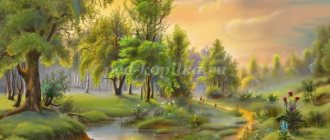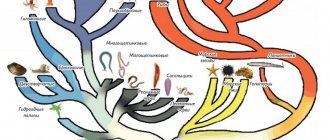Plan of an excursion to the park in the summer with children 5-7 years old
Outline of an excursion to the park in the summer with children 5-7 years old
Prepared by:
Educator
1 qualification category
Vasilyeva T.V.
Target:
develop skills in observing changes in nature, arouse the desire for independent research.
Tasks:
- Expand understanding of the habitat, its factors and their influence on living organisms;
- continue to develop a culture of communication with nature and respect for it
Equipment
:
- notepads, pencils, camera.
2. Working in a group.
3. Summing up.
Excursion location
: walk in the park
Preparing for the excursion:
- Plan your excursion route.
- Have a conversation about nature conservation.
Preparing for the excursion:
1. Talk about different types of trees, shrubs, and mosses.
2. Prepare children to perceive nature, draw attention to the objects of the “forest” ecosystem. Develop the ability to behave correctly in nature.
3. Give the concept of “tiering”.
Progress of the excursion.
Review the rules of conduct on excursions
Educator:
Guys, we're going on an excursion. Let's remember what rules need to be followed in nature, in the forest, in the park? (Children answer)
- You cannot light a fire in the forest during a fire-hazardous time; before leaving, you must carefully check the place where the fire burned to see if it has been properly extinguished.
- When in nature, you should not pick plants for bouquets. Bouquets can only be made from plants grown by humans.
- Do not break branches of trees and bushes. Let beautiful plants and trees remain in nature.
- In nature, especially in the forest, you need to try to walk along paths so that the plants do not die from trampling.
Educator:
That's right, well done guys! Now we are ready to go for a walk.
During the conversation, the teacher reveals the features of the life of plants, birds, and animals in the park area. Pays attention to the relative location of trees, shrubs, and herbaceous plants. Gives the concept of tiering. Shows children the tiers of a plant community and helps them identify the types of plants in each tier. Draws attention to the non-simultaneous development of plants. What flowers begin to develop before the leaves bloom on the trees. Before the leaves bloom, wind-pollinated plants also bloom. The more pronounced the layering and mosaic pattern in the forest, the more habitats there are for animals, fungi, and bacteria in the community.
Educator:
Tiers - “floors of the forest” - interact with each other. Tall trees protect the life of shorter plants. Branches and leaves fall on the ground layer (soil). Water and various minerals and nutrients move from the underground layers to the aboveground ones. I draw your attention to organisms that use plants as a habitat: mosses and lichens live on the bark of trees; The fruiting bodies of tinder fungi on tree trunks can be considered an example of a parasitic relationship between fungi and plants. Plants form the basis of a community. Animals mainly consume plants for living.
Assignments for independent work.
Task No. 1.
Sketch the plants, birds, animals that you met on the excursion. For work we use colored pencils and notepads.
Task No. 2
We compose short descriptive stories about trees and shrubs, flowers and herbs. You can use your own sketches for stories.
Task No. 3
We collect herbs, cones and leaves for the herbarium.
Summarizing
Educator:
did you enjoy the walk? What do you remember most?
In the group we will organize a photo exhibition and an exhibition of children's sketches.






